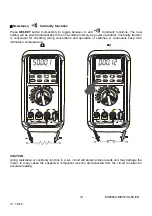
5 MM560A-MM570A-EU-EN
V1.1 8/12
Average sensing RMS calibrated
RMS (Root-Mean-Square) is the term used to describe the effective or equivalent DC value of an AC
signal. Most digital multimeters use average sensing RMS calibrated technique to measure RMS
values of AC signals. This technique is to obtain the average value by rectifying and filtering the AC
signal. The average value is then scaled upward (calibrated) to read the RMS value of a sine wave. In
measuring pure sinusoidal waveform, this technique is fast, accurate, and cost effective. In measuring
non-sinusoidal waveforms, however, significant errors can be introduced because of different scaling
factors relating average to RMS values.
AC True RMS
AC True RMS, normally refers as True RMS, identifies a DMM function that is AC coupled, and
responds accurately only to the effective RMS AC component value regardless of the waveforms.
However, DC component plays an important role in the distorted non-symmetrical waveforms, and will
also be of interest sometimes. A full wave rectified sine waveform is a good example, and the AC true
RMS function will only give the AC component reading which is at 43.6% of the total effective DC+AC
RMS reading.
DC+AC True RMS
DC+AC True RMS calculates both of the AC and DC components given by the expression
when making measurement, and can responds accurately to the
total effective RMS value regardless of the waveform. Distorted waveforms with the presence of DC
components and harmonics may cause:
1)
Overheated transformers, generators and motors to burn out faster than normal
2)
Circuit breakers to trip prematurely
3)
Fuses to blow
4)
Neutrals to overheat due to the triplen harmonics present on the neutral
5)
Bus bars and electrical panels to vibrate
AC Bandwidth
AC bandwidth of a DMM is the range of frequencies over which AC measurements can be made within
the specified accuracy. It is not the frequency measurement function, and is the frequency response of
the AC functions. A DMM cannot accurately measure the AC value with frequency spectrums beyond
the AC bandwidth of the DMM. Therefore, wide AC bandwidth plays an important role in high
performance DMMs. In reality, complex waveforms, noise and distorted waveforms contain much
higher frequency spectrum than its fundamental.
NMRR (Normal Mode Rejection Ratio)
NMRR is the DMM's ability to reject unwanted AC noise effect that can cause inaccurate DC
measurements. NMRR is typically specified in terms of dB (decibel). This series has a NMRR
specification of > 60dB at 50 and 60Hz, which is a good and definite ability to reject the effect of AC
noise when making DC measurements.
CMRR (Common Mode Rejection Ratio)
Common mode voltage is voltage present on both the COM and VOLTAGE input terminals of a DMM,
with respect to ground. CMRR is the DMM's ability to reject common mode voltage effect that can






































